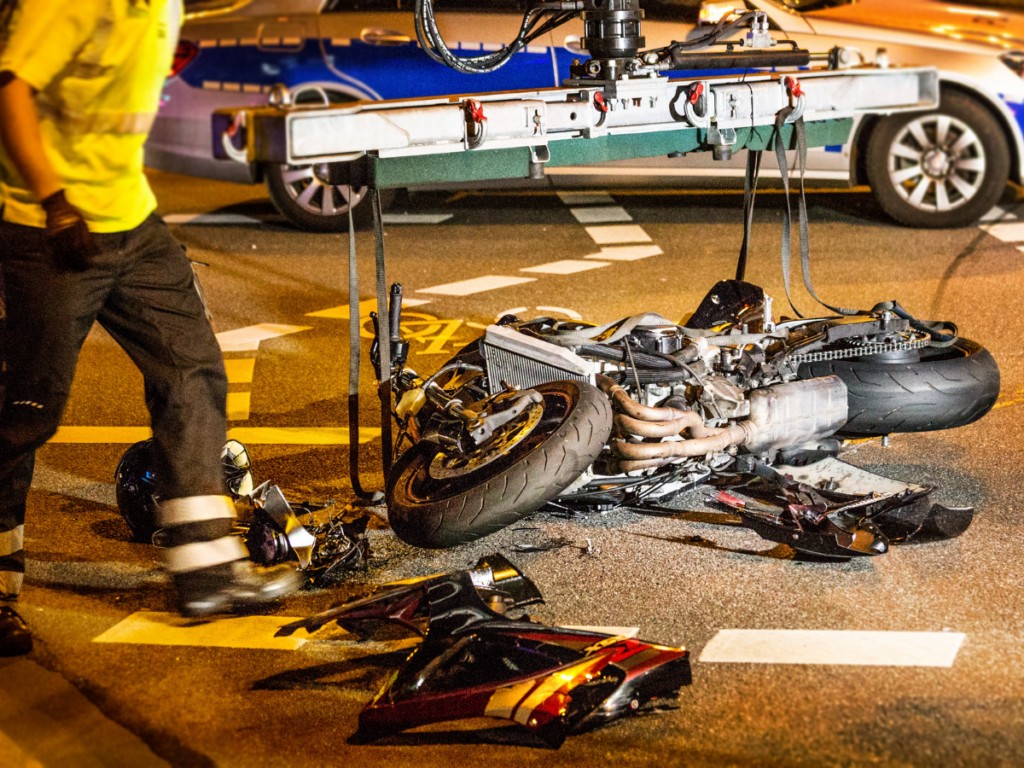Motorcycles offer a unique sense of freedom and are often lauded for their fuel efficiency and agility, especially in congested urban environments like New York City. They present a compelling alternative to cars for many commuters. However, beneath the allure of the open road lies a stark reality: motorcycles are significantly more dangerous than cars. While motorcycles provide convenience and economic benefits, it’s crucial to acknowledge and understand the heightened risks riders face compared to those in passenger vehicles. Motorcyclists share the road with cars, trucks, and SUVs, and while most riders are responsible and law-abiding, they are disproportionately vulnerable to accidents and severe consequences when collisions occur.
 A wrecked motorcycle lies on the street after a traffic collision, illustrating the increased danger faced by motorcyclists compared to car drivers in accidents.
A wrecked motorcycle lies on the street after a traffic collision, illustrating the increased danger faced by motorcyclists compared to car drivers in accidents.
The Sheer Statistics: Quantifying the Danger
The numbers paint a clear picture. In a recent year, 5,579 motorcyclists perished in traffic accidents. Data from the National Highway Traffic Safety Administration (NHTSA) reveals a shocking disparity: in the event of a crash, a motorcycle rider is a staggering 28 times more likely to die than someone inside a car. Furthermore, in 80 percent of reported motorcycle accidents, riders sustain injuries or fatalities. These statistics underscore a critical point: motorcycle accidents are not only more frequent relative to miles traveled compared to car accidents, but they are also far more likely to result in severe harm or death.
This increased danger stems from the fundamental differences in vehicle construction and safety features. Cars are engineered with a protective metal shell, seatbelts, and airbags, all designed to mitigate impact forces and shield occupants during a crash. Motorcycles, conversely, offer virtually no external protection. Riders are exposed, and in a collision, their bodies directly absorb the impact. The physics of a motorcycle accident often involve the rider being thrown from the bike, potentially traveling through the air before violently impacting the ground or another object. This ejection and subsequent impact are major factors contributing to the severity of motorcycle accident injuries.
Why Motorcycle Accidents are More Dangerous: Key Contributing Factors
Several factors contribute to the heightened danger of motorcycle riding. These can be broadly categorized into driver-related issues and road condition hazards.
Negligent Drivers: A Major Threat to Motorcyclists
A primary cause of motorcycle accidents is the negligence of other drivers, particularly those operating cars. This is why a significant proportion of motorcycle accidents occur in densely populated urban areas where car traffic is heavier. Careless, impaired, and inexperienced drivers pose a substantial risk to motorcyclists. Accidents are more frequent during nighttime hours when visibility is reduced and the incidence of drunk driving increases. Alarmingly, unlicensed drivers are implicated in a considerable percentage of motorcycle accidents, highlighting a broader issue of unqualified and unsafe drivers on the road.
Specific unsafe driving behaviors that commonly lead to motorcycle accidents include:
- Driving Under the Influence (DUI): Alcohol and drugs severely impair judgment and reaction time, critical for safe driving and hazard perception, especially around vulnerable motorcyclists.
- Distracted Driving: Mobile phones, infotainment systems, and other distractions divert driver attention, leading to missed observations of motorcycles, particularly in blind spots.
- Speeding: Excessive speed reduces reaction time and increases the severity of crashes, making it harder for drivers to avoid motorcycles and for riders to control their bikes in emergency situations.
- Tailgating: Following too closely gives drivers insufficient time to react to sudden braking or maneuvers by motorcycles.
- Aggressive Driving: Erratic lane changes, sudden acceleration, and other aggressive behaviors create unpredictable and dangerous situations for motorcyclists.
- Unsafe Turns: Failing to check for motorcycles when turning left or right at intersections is a common cause of collisions.
- Unexpected Stops: Abrupt stops without adequate warning can lead to rear-end collisions involving motorcycles.
- Dangerous Maneuvers: Illegal or risky maneuvers performed by car drivers often catch motorcyclists off guard, leading to accidents.
- Unsafe Merges and Lane Changes: Failing to properly check blind spots when merging or changing lanes frequently results in drivers sideswiping or cutting off motorcycles.
Hazardous Road Conditions: Amplifying Motorcycle Instability
Poor road maintenance and design are another significant contributor to motorcycle accidents. Motorcycles, with only two wheels, are inherently less stable than cars. Road hazards that might be minor inconveniences for cars can become serious dangers for motorcycles. Wet roads, loose gravel, or sand significantly reduce tire traction, increasing the risk of falls and loss of control. Damaged roads with potholes, uneven pavement, and road debris create substantial hazards for motorcycles. Inadequate street lighting, obscured or missing road signs, and malfunctioning traffic signals further compound these dangers, causing confusion and increasing accident risk, especially at intersections.
Unsafe road conditions stemming from poor maintenance that frequently cause motorcycle accidents include:
- Potholes: These can cause loss of control, tire damage, and rider ejection.
- Drop-offs: Sudden changes in road surface height can destabilize motorcycles, particularly when leaned into turns.
- Poor Lighting: Inadequate illumination reduces visibility, making it harder for riders to see hazards and for other drivers to see motorcycles, especially at night or in low-light conditions.
- Slippery Surfaces: Oil spills, gravel, sand, and wet surfaces drastically reduce tire grip, leading to skids and falls.
- Debris: Road debris, such as tire fragments, cargo, or construction materials, can cause punctures, loss of control, or act as obstacles leading to crashes.
- Large Objects in the Road: Anything from fallen branches to larger debris presents a direct collision hazard for motorcycles.
- Uneven or Improperly Graded Pavement: Inconsistent road surfaces can upset motorcycle balance and control, especially at speed or in turns.
Devastating Injuries: The Human Cost of Motorcycle Accidents
The lack of physical protection inherent in motorcycle riding means that riders and passengers are exceptionally vulnerable to severe injuries when accidents occur. Common injuries sustained in motorcycle accidents are often life-altering and include:
- Bone Fractures: From minor breaks to complex, multiple fractures, impacting limbs, ribs, and collarbones are common due to direct impact and falls.
- Road Rash: Severe abrasions caused by sliding across pavement, often requiring extensive skin grafts and leading to permanent scarring.
- Paralysis: Spinal cord injuries resulting from high-impact crashes can lead to partial or complete paralysis, with devastating long-term consequences.
- Amputation: Crushing injuries or severe vascular damage in accidents may necessitate amputation of limbs.
- Whiplash: Sudden, forceful neck movements in collisions can cause whiplash, leading to chronic pain and mobility issues.
- Biker’s Arm: Nerve damage to the arm and shoulder, often caused by the impact of falling on an outstretched arm, resulting in weakness or paralysis.
- Organ Failure: Internal injuries from blunt force trauma can cause severe organ damage and failure, requiring intensive medical intervention.
- Lacerations: Deep cuts from debris, vehicle parts, or the road surface, often requiring stitches and carrying a risk of infection.
- Nerve Damage: Beyond biker’s arm, nerves throughout the body can be damaged in crashes, leading to chronic pain, numbness, and impaired function.
Mitigating Risks: Riding Safe and Sharing the Road
While the inherent dangers of motorcycle riding are undeniable, risks can be mitigated through proactive measures. Comprehensive rider training, defensive riding techniques, and consistent use of high-quality protective gear, including helmets, jackets, gloves, and boots, are crucial for rider safety. Regular motorcycle maintenance ensures the bike is in optimal condition to prevent mechanical failures that could contribute to accidents. Furthermore, improvements in road infrastructure, such as better lighting, road surface maintenance, and clear signage, can reduce environmental hazards. Perhaps most importantly, fostering a culture of driver awareness and mutual respect between car drivers and motorcyclists is essential for creating safer roads for everyone. Car drivers need to actively look out for motorcycles, especially at intersections and in blind spots, and understand the unique vulnerabilities of riders.
Conclusion: Acknowledging the Risk, Promoting Responsibility
Motorcycles, while offering certain advantages, are demonstrably and statistically more dangerous than cars. The lack of protection, combined with factors like negligent drivers and hazardous road conditions, significantly elevates the risk of severe injury or fatality for motorcyclists. Understanding this increased risk is the first step towards promoting safer riding practices, encouraging driver awareness, and ultimately reducing the number of motorcycle accidents and their devastating consequences. Responsible riding, vigilant driving, and continuous efforts to improve road safety are paramount to minimizing the inherent dangers and ensuring that motorcycles can be enjoyed as safely as possible.
